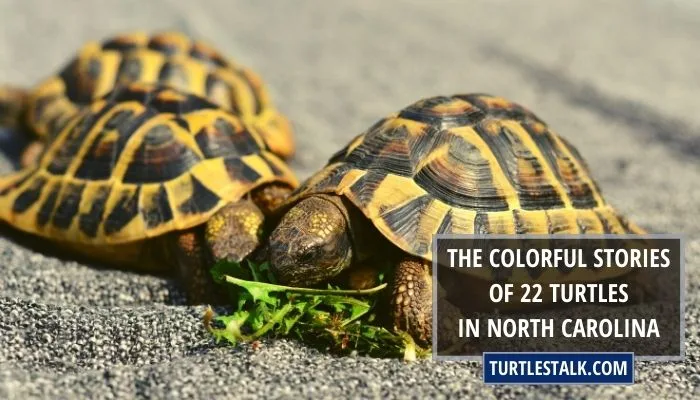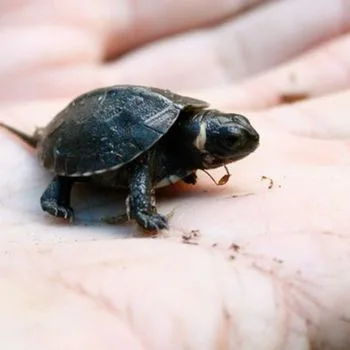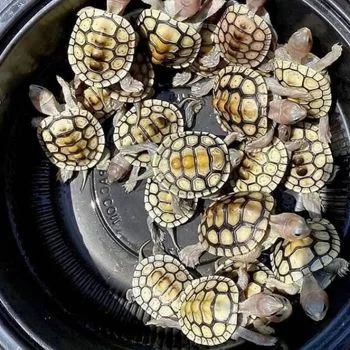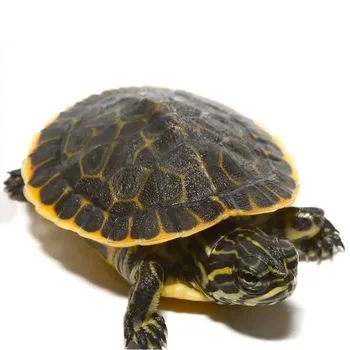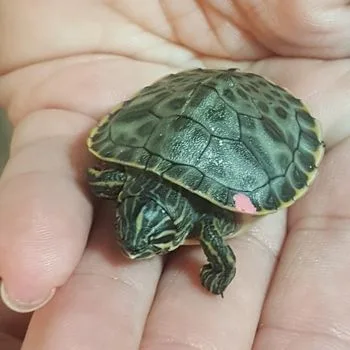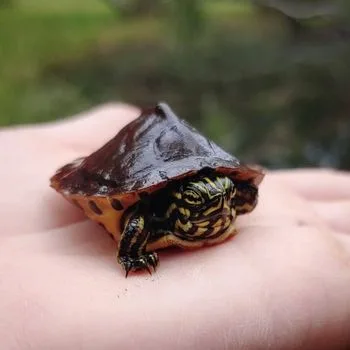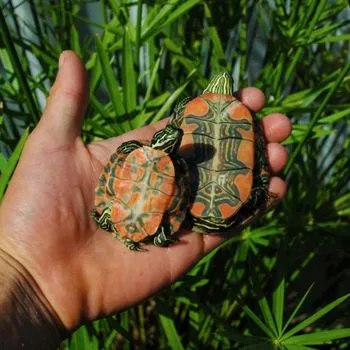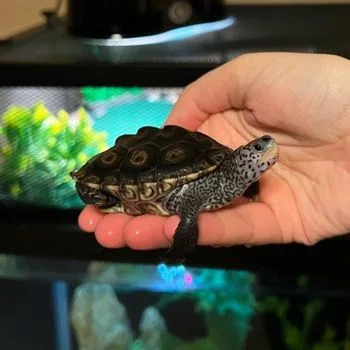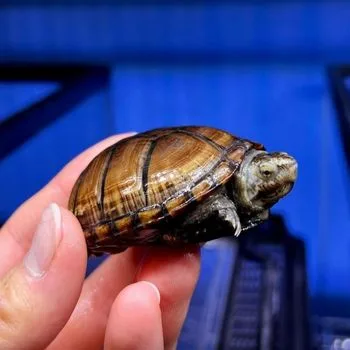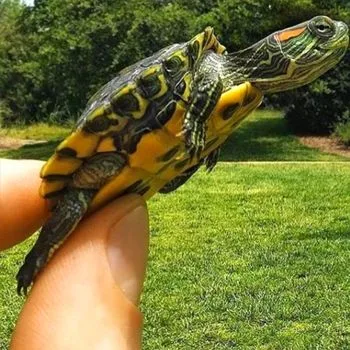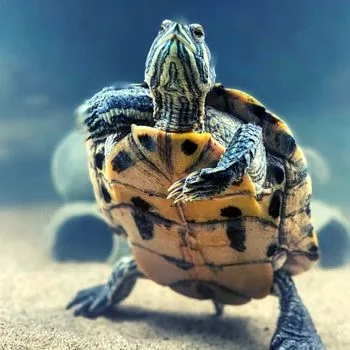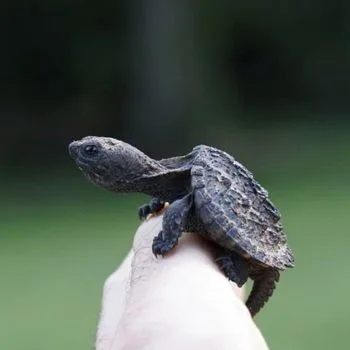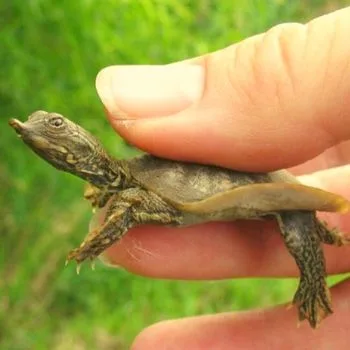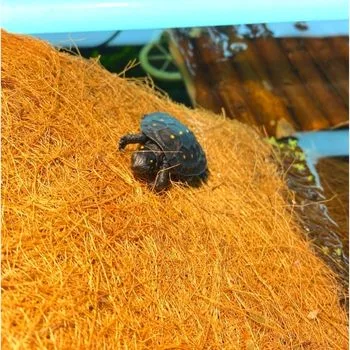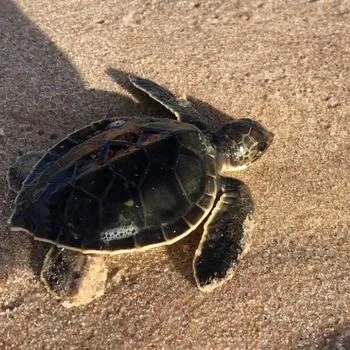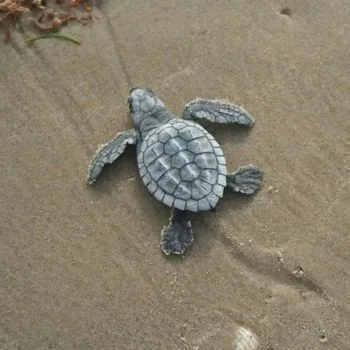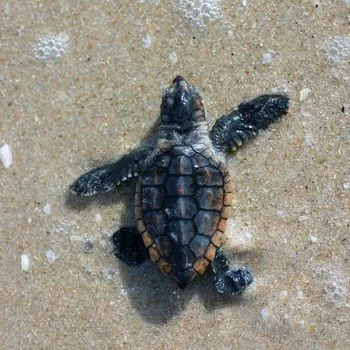The Colorful Stories of 22 Turtles in North Carolina
Greetings, fellow nature lovers! Are you ready to explore the amphibious wonders of North Carolina? From sea turtles to box turtles and everything in between, this beautiful state is home to 22 species of turtles.
You can find fully aquatic species that inhabit water bodies across the state as well as semi-aquatic ones and even a completely terrestrial one – the box turtle! So grab your binoculars, put on your hiking shoes, and let’s embark on an adventure through some of North Carolina’s most amazing reptilian residents.
| # | Name | Details | Image |
| 1 | Bog Turtle |
| 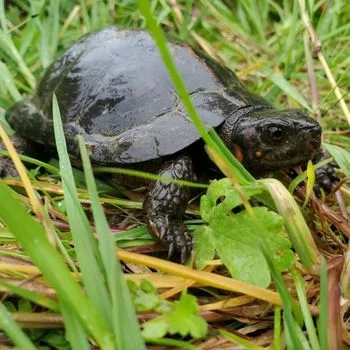 |
| 2 | Eastern Box Turtle (Terrapene Carolina) |
| 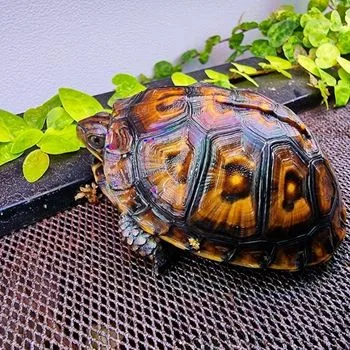 |
| 3 | Eastern Chicken Turtle (Deirochelys Reticularia) |
| 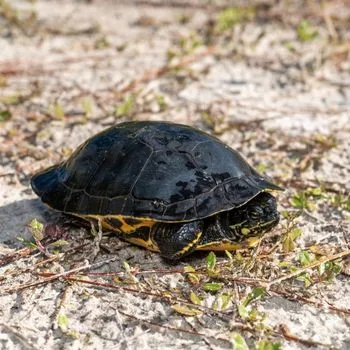 |
| 4 | Eastern River Cooter (Pseudemys Concinna) |
| 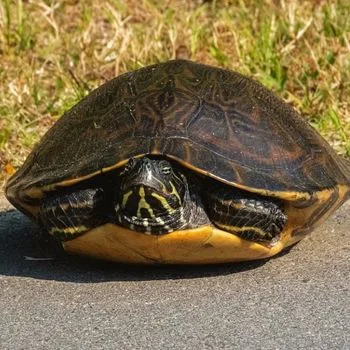 |
| 5 | Florida Cooter (Pseudemys Floridana) |
| 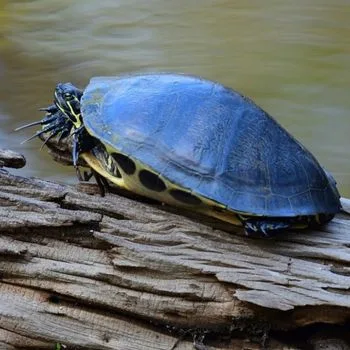 |
| 6 | Northern Red-Bellied Cooter (Pseudemys Rubriventris) |
| 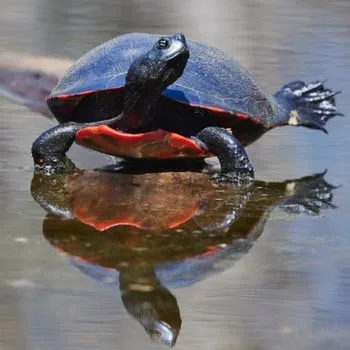 |
| 7 | Diamondback Terrapin (Malaclemys Terrapin) |
| 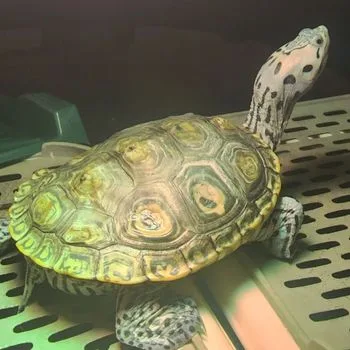 |
| 8 | Eastern Mud Turtle (Kinosternon Subrubrum) |
| 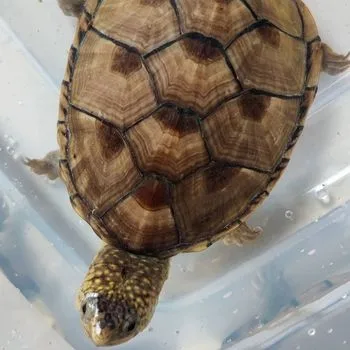 |
| 9 | Red Eared Slider (Trachemys Scripta Elegans) |
| 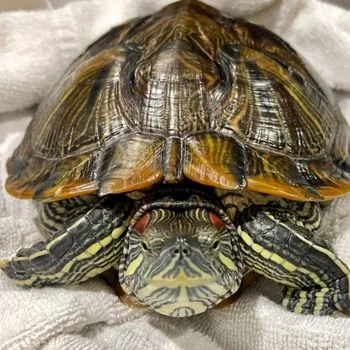 |
| 10 | Yellow-bellied Slider (Trachemys Scripta Scripta) |
| 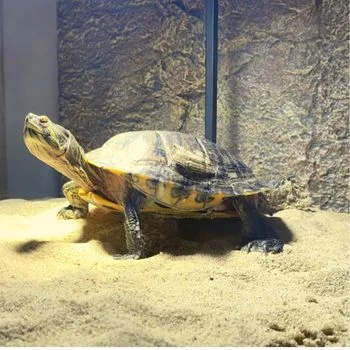 |
| 11 | Common Snapping Turtle (Chelydra serpentina) |
| 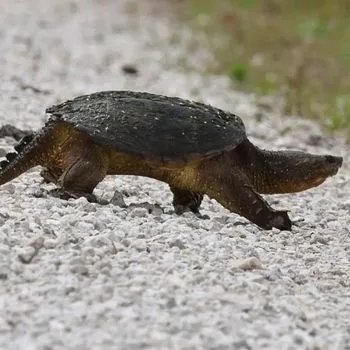 |
| 12 | Spiny Softshell Turtle (Apalone Spinifera) |
| 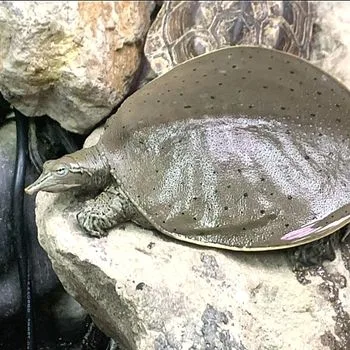 |
| 13 | Spotted Turtle (Clemmys Guttata) |
| 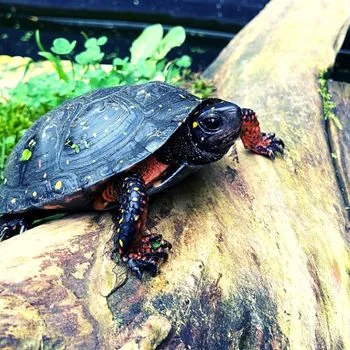 |
| 14 | Green Sea Turtle (Chelonia Mydas) |
| 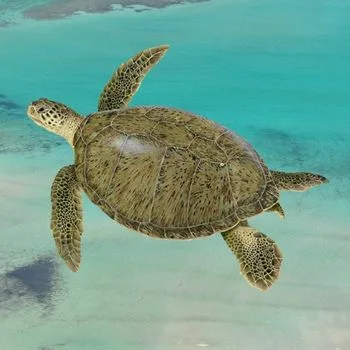 |
| 15 | Hawksbill Sea Turtle (Eretmochelys Imbricata) |
| 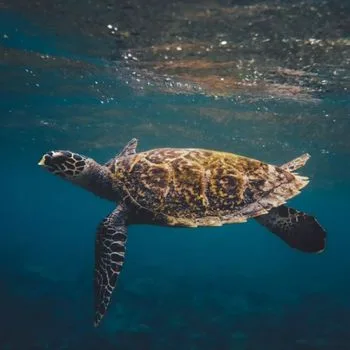 |
| 16 | Kemp’s Ridley Sea Turtle (Lepidochelys kempii) |
| 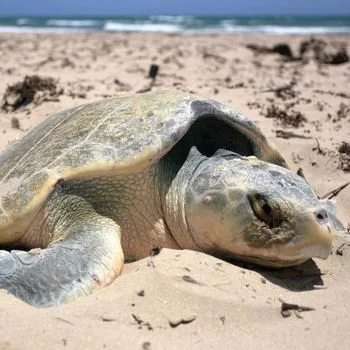 |
| 17 | Leatherback Sea Turtle (Dermochelys Coriacea) |
|  |
| 18 | Loggerhead Sea Turtle (Caretta Caretta) |
| 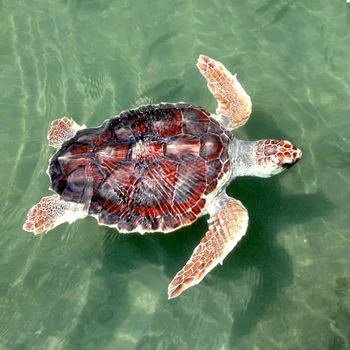 |
22 Turtles You Can Find in North Carolina
In total, there are 22 species of turtles in the state of North Carolina. This guide will take you on an exploration through each turtle type and provide tips for providing them with proper care. So, let’s get started on our journey into discovering all the wonders that these reptiles have to offer!
1. Bog Turtle
- Family: Emydidae
- Genus: Glyptemys
- Type: Terrestrial turtle
- Natural Habitat: Wetlands, bogs, and swamps
- Lifespan: 20-30 years
- Maximum Size: 4-5 inches
- Maximum Weight: 1-2 pounds
- Prone to Diseases: Parasites and fungal infections
- Aggression Level: Mildly aggressive, may bite if threatened
- Predators: Skunks, raccoons, and foxes
- Domestication: Illegal to possess without permit in most states
The Bog Turtle, or Glyptemys muhlenbergii, is a critically endangered species of turtle native to wetlands, bogs, and swamps in the Northeastern and north-central United States. With a carapace length of 4-5 inches and weighing around 1-2 pounds, there is no size variation between male and female Bog Turtles. They have a lifespan of 20-30 years.
Skunks, raccoons, foxes and humans are the main predators of these turtles as juveniles are highly vulnerable due to their small size. Unfortunately, they also face threats from exploitation for the pet trade—it is illegal to remove them from the wild and possess them without a permit in most states. Bog Turtles are not commonly kept as pets as they require special environments to thrive in captivity. In addition, these turtles tend to be mildly aggressive and may bite if threatened.
Bog Turtles are not well adapted to aquatic life; instead they prefer warm humid climates like those found in North Carolina. As such they face massive habitat destruction due to urbanization which has led to their listing as an Endangered Species by the Endangered Species Act in several states including New York, Pennsylvania, and Vermont.
To help protect this species it is important for conservation efforts to continue in North Carolina so that healthy ecosystems can be maintained throughout its range. Moreover, educational initiatives need to be established that inform people about the importance of protecting Bog Turtles before their population further declines due to the illegal collection for the pet trade and habitat loss.
2. Eastern Box Turtle (Terrapene Carolina)
- Family: Emydidae
- Genus: Terrapene
- Type: Terrestrial turtle
- Natural Habitat: Deciduous and mixed forests, meadows, and fields
- Lifespan: 60 years
- Also Known As: Eastern terrapin
- Maximum Size: 4-10 inches
- Maximum Weight: Male: 1 pounds, females: 2 pounds
- Prone to Diseases: Respiratory infections, shell rot, and other diseases
- Aggression Level: Not aggressive towards humans
- Predators: Raccoons, skunks, opossums, and snakes
- Domestication: Can be kept as pets
The Eastern Box Turtle (Terrapene Carolina) is one of the most intriguing species found in deciduous and mixed forests, meadows, and fields of eastern North America. This incredible turtle can live up to 40 years in the wild or even reach up to 60 years in captivity! With adult sizes ranging from 4-10 inches, males being slightly smaller than females with a weight of 0.5-1 lb for males and 1-2 lbs for females.
Eastern Box Turtles are not too aggressive towards humans but potential predators may include raccoons, skunks, opossums, and snakes. They can be kept as pets but it is important to consult local laws before doing so since some states make it illegal to collect wild turtles or sell them as pets—including North Carolina. Captive Eastern Box Turtles may be prone to respiratory infections, shell rot, and other diseases common to captive turtles.
This species is state-protected in several states due to the declining population caused by habitat loss and illegal collection for the pet trade. Despite this precarious situation, Eastern Box Turtles can still be found in eastern North America—including North Carolina. It is essential that we take steps to protect this species which calls North Carolina home by preserving their natural habitats as well as improving public awareness of their plight!
3. Eastern Chicken Turtle (Deirochelys Reticularia)
- Family: Emydidae
- Genus: Deirochelys
- Type: Freshwater turtle
- Natural Habitat: Wetlands, swamps, and rivers in the southeastern united states
- Lifespan: 30 years
- Maximum Size: 8 inches
- Maximum Weight: 2 pounds
- Prone to Diseases: Respiratory infections, shell rot, and other infections
- Aggression Level: Not aggressive
- Predators: Snakes, birds, and mammals
- Domestication: Can be kept as a pet
The Eastern Chicken Turtle (Deirochelys Reticularia) is a freshwater turtle species found in wetlands, swamps and rivers of the southeastern United States. It can reach up to 8 inches (20 cm) in length and live for up to 30 years. The Eastern Chicken Turtle has no size variations between birth, juvenile, adult, male and female individuals, nor does it have any other name than its own. This shy creature is not known for being aggressive towards humans but needs to watch out from potential predators such as snakes, birds, mammals or even us humans.
This species of turtle can be kept as pets but considering some states might make it illegal to collect wild turtles or sell them as pets without proper permits—including North Carolina—it is important people check with local wildlife regulations before doing so.
In captivity they may be prone to respiratory infections, shell rot or other infections common to captive specimens; however they are well-adapted aquatic habitats that might help prevent those issues from occurring if kept adequately hydrated.
Even though they are not necessarily endangered yet we should still strive to preserve their natural habitats by taking steps that improve public awareness of the challenges this species faces while living in North Carolina.
4. Eastern River Cooter (Pseudemys Concinna)
- Family: Emydidae
- Genus: Pseudemys
- Type: Freshwater turtle
- Natural Habitat: Slow-moving rivers, swamps, and other aquatic environments
- Lifespan: 30 years
- Maximum Size: 11 inches
- Maximum Weight: 8 pounds
- Prone to Diseases: Respiratory infections, shell rot, and parasites
- Aggression Level: Not known to be aggressive
- Predators: Raccoons, foxes, etc.
- Domestication: Can be kept as pets
The Eastern River Cooter (Pseudemys concinna) is a beautiful freshwater turtle found in the southeastern United States, including states such as Alabama, Georgia, South Carolina, North Carolina and Florida. With its wide flat shell adorned with striking markings of yellow and red it’s certainly an impressive sight to behold.
These unique creatures typically grow up to 10-15 inches in length; males usually being smaller than females. They have strong webbed feet and streamlined shells that make them exceptionally adapted to aquatic environments like slow-moving rivers, swamps, and lakes of North Carolina. In the wild they can live up to 30 years but if well looked after they can reach 20 or more years in captivity; making them attractive pet options for those looking for long term companionship.
Their natural habitats however are under threat due to human activity so by protecting their environment we can help ensure that this stunning species remain part of our ecosystem for many generations in North Carolina.
5. Florida Cooter (Pseudemys Floridana)
- Family: Emydidae
- Genus: Pseudemys
- Type: Freshwater turtle
- Natural Habitat: Freshwater habitats such as ponds, swamps, lakes, and rivers in the southeastern united states
- Lifespan: 30-40 years
- Maximum Size: 18 inches
- Maximum Weight: Males: 1.5 pounds, females: 9 pounds
- Prone to Diseases: Respiratory infections and shell rot
- Aggression Level: Low
- Predators: Birds of prey, mammals, and alligators
- Domestication: Can be kept as pets
The Florida Cooter (Pseudemys Floridana) is an incredible species of freshwater turtle that inhabits ponds, swamps, lakes and rivers in the southeastern United States.
This stunning reptile can reach up to 18 inches in length and males typically weigh about 1.5 pounds whilst females can be as heavy as 9 pounds. Despite their intimidating size, these turtles are not aggressive by nature but face threats from human activities such as over-collection for the pet trade or habitat loss in North Carolina.
In order to ensure thriving wild populations of this beautiful creature it’s important to observe local laws regarding possession before bringing one into your home and provide them a clean enclosure which simulates their natural conditions for optimum health.
6. Northern Red-Bellied Cooter (Pseudemys Rubriventris)
- Family: Emydidae
- Genus: Pseudemys
- Type: Aquatic turtle
- Natural Habitat: Rivers, swamps, and large ponds in the eastern united states
- Lifespan: Can live up to 50 years
- Also Known As: Cooters
- Maximum Size: 10 to 13.5 inches
- Maximum Weight: 12+ pounds
- Prone to Diseases: Mucinous melanophoroma
- Aggression Level: Not aggressive
- Predators: Raccoons, humans
- Domestication: Can be kept as pet
This one is an aquatic turtle native to rivers, swamps, and large ponds in the eastern United States. They reach an average length of 8 to 11 inches with adult males being slightly smaller than females.
These turtles may be kept as pets but require a large aquarium due to their size. Despite their small appearance they are not regarded as aggressive animals so there’s no need for fear if you come across one near North Carolina, simply observe from a respectable distance!
Of course taking them home without permits or licenses is highly illegal – something I’m sure any red-blooded American would know already!
7. Diamondback Terrapin (Malaclemys Terrapin)
- Family: Emydidae
- Genus: Malaclemys
- Type: Aquatic turtle
- Natural Habitat: Coastal salt marshes and brackish waterways along the atlantic and gulf coasts of the united states
- Lifespan: 20 years
- Maximum Size: 11 inches
- Maximum Weight: Male: 11 ounces, females: 18 ounces
- Prone to Diseases: Shell rot and respiratory infections
- Aggression Level: Mildly aggressive when threatened
- Predators: Raccoons, otters, foxes, and birds of prey
- Domestication: Can be kept as a pet
The Diamondback Terrapin, native to the brackish waterways of the Atlantic and Gulf coasts in states such as Maryland, Virginia, North Carolina, South Carolina, Georgia, Florida, Louisiana and Alabama is a species worth noting.
With lifespans up to 20 years and adult sizes ranging from 8-9 inches in length with some reaching 11 inches this turtle is not one to be missed. Despite its mild aggression when threatened due to predators such as raccoons and otters it still belongs here in North Carolina.
However it is important if you are considering owning one as a pet that you check local laws first as regulations do vary state by state. Although they are well adapted to their brackish water environments they can be prone diseases like shell rot or respiratory infections so special care needs must be taken when kept captive.
Habitat loss or harvest for commercial trade have caused vulnerability in the species which makes them vulnerable to extinction -so please enjoy these remarkable creatures responsibly here at North Carolina.
8. Eastern Mud Turtle (Kinosternon Subrubrum)
- Family: Kinosternidae
- Genus: Kinosternon
- Type: Mud turtle
- Natural Habitat: Freshwater wetlands, swamps, and slow-moving streams
- Lifespan: 30 years
- Maximum Size: 5 inches
- Maximum Weight: 9.27 ounces
- Aggression Level: Low
- Predators: Raccoons, snakes, and birds of prey
- Domestication: Not suitable as a pet
The Eastern Mud Turtle (Kinosternon subrubrum) is a small freshwater turtle found in the southeastern United States, including North Carolina. This species of turtle is known for its highly aquatic adaptations and webbed feet, which make it well-suited to life in slow-moving streams, swamps, and wetlands. The Eastern Mud Turtle can reach up to 5 inches in length and has a maximum weight of 9.27 ounces. It is not aggressive, but may bite if provoked—so exercise caution when near any wild turtles!
The diet of the Eastern Mud Turtle consists primarily of aquatic invertebrates such as snails, worms, and insects. They are also opportunistic scavengers, meaning they will take advantage of carrion when available. Predators of this species include raccoons, snakes, and birds of prey. The lifespan of these turtles is up to 30 years in the wild and due to their abundance across the southeastern United States are not listed as threatened or endangered.
Although they do not make suitable pets due to their size and temperament being unsuitable for captivity, taking care to observe local wildlife regulations is important when interacting with wild Eastern Mud Turtles in North Carolina . Taking steps such as preserving their natural habitats helps protect this species from destruction or poaching—ensuring they remain an iconic part of our environment for many more years to come!
9. Red Eared Slider (Trachemys Scripta Elegans)
- Family: Emydidae
- Genus: Trachemys
- Type: Aquatic turtle
- Natural Habitat: Streams, rivers, ponds, lakes, swamps, and marshes
- Lifespan: 20 – 30 years
- Also Known As: Red-eared terrapin
- Maximum Size: 7 – 12 inches, females get larger than 12 inches
- Maximum Weight: 3 – 6 pounds
- Prone to Diseases: Respiratory infections, shell rot, and other diseases if kept in unsanitary conditions.
- Disease Carrier: Salmonella
- Aggression Level: Not aggressive
- Predators: Raccoons, otters, fish, frogs, snakes, skunks and birds
- Domestication: Can be kept as pets
The Red Eared Slider (Trachemys scripta elegans) is a freshwater reptile with a striking appearance. Found in North Carolina’s waterways, these turtles can reach up to 10-12 inches long as adults and can live for an impressive 30 years. They have webbed feet that are adapted for swimming, making them incredibly agile aquatic creatures.
Males and females exhibit different size ranges, with males being more diminutive compared to the females and juveniles measuring only 2-3 inches when fully grown. Although they may take on aggressive postures if threatened, their bite force is not enough to cause any damage to humans or other larger animals.
It’s important that we respect the habitats of these amazing reptiles so that future generations will be able to enjoy them too – keep their environments clean by disposing of garbage properly and avoid disturbing the fragile ecosystems where they make their homes!
10. Yellow-bellied Slider (Trachemys Scripta Scripta)
- Family: Emididae
- Genus: Trachemys
- Type: Freshwater turtle
- Natural Habitat: Slow-moving rivers, floodplain swamps, marshes, seasonal wetlands, and permanent ponds
- Lifespan: 20-30 year
- Maximum Size: 8 – 12 inches
- Maximum Weight: Up to 3 pounds
- Disease Carrier: Salmonella
- Aggression Level: When kept in pairs, yellow-bellied slider turtles may exhibit aggression, unlike their docile behavior when housed individually.
- Predators: Raccoons (procyon lotor) and humans, who shoot them while basking, kill them on roads, and fracture shells with boat propellers. hatchlings and juveniles are eaten by large fish, some snakes, raccoons, and wading birds
Native to the southeastern United States from Florida to Virginia, the Yellow-bellied Slider (Trachemys Scripta Scripta) is a freshwater turtle. These beautifully patterned creatures have yellow shells with black patches around each scute as well as bright yellow bellies, giving them their name. They can measure up to 12 inches long and weigh up to 3 pounds.
In North Carolina, these turtles are found in low-moving rivers, floodplain swamps, marshes, seasonal wetlands and permanent ponds . In the wild they usually lead solitary lives and do not show aggression towards other animals unless kept in pairs when some competition may arise over certain mates.
Sadly raccoons (Procyon lotor) and humans are major threats for these vulnerable reptiles due to disturbance of their habitats or hunting them down for food or sport; juveniles also face even more trouble since they’s likely be eaten by large fish, some snakes, raccoons and wading birds if left unprotected! Conservation efforts need to be increased so that this majestic species will continue inhabiting our planet far into future generations!
11. Common Snapping Turtle (Chelydra serpentina)
- Family: Chelydridae
- Genus: Chelydra
- Type: Freshwater turtle
- Natural Habitat: Freshwater habitats such as lakes, rivers, and swamps
- Lifespan: 50 years
- Maximum Size: 19 inches
- Maximum Weight: 40 pounds
- Prone to Diseases: Fungal infections and shell rot
- Aggression Level: Not aggressive until provoked
- Predators: River otters, bears and coyotes
- Domestication: Not recommended as pets
The Common Snapping Turtle, scientifically known as Chelydra serpentina, is an aquatic species native to freshwater habitats such as lakes, rivers and swamps. These turtles are highly adaptable and can live up to 50 years in the wild.
Adult Common Snapping Turtles typically measure 10-16 inches in shell length but can grow up to 19 inches and weigh around 40 pounds. They have a powerful bite with an estimated pressure of over 600 psi, making them one of the strongest biters among reptiles. Despite their strength they are generally not aggressive animals, though it is best to not provoke them and take caution around them.
Common Snapping Turtles often face threats from predators such as river otters, bears and coyotes when living out in the wild.
Unfortunately, their habitat is also threatened by human activities such as development and pollution which can lead to a decrease in population numbers if conservation efforts are not taken soon here in North Carolina.
Although they make fascinating pets due to their long lifespan of up to 50 years when cared for properly, some states have regulations or restrictions on owning them so check with local authorities before acquiring this species as a pet.
These turtles have webbed feet for swimming and a long tail for propulsion allowing them to move quickly through water which also makes them difficult prey for predators.
Furthermore, although they occupy multiple states across North America from Alabama to Wyoming there is no other name than the Common Snapping Turtle so it’s easy to identify.
It should be noted that this species does not carry any significant disease that can be transmitted to humans yet they may still be prone to diseases like fungal infections or shell rot when kept in unsanitary conditions so proper care must be taken here in North Carolina when considering owning one of these remarkable creatures as a pet.
12. Spiny Softshell Turtle (Apalone Spinifera)
- Family: Trionychidae
- Genus: Apalone
- Type: Freshwater turtle
- Natural Habitat: Predominantly discovered in rivers and lakes, can also be found in nearby creek beds and smaller water bodies such as ditches and ponds.
- Lifespan: 40+ years
- Also Known As: Spinifera (spine-bearing), spiny
- Maximum Size: 8 – 20+ inches
- Maximum Weight: 25 pounds
- Prone to Diseases: Vitamin deficiencies, metabolic bone disease, and intestinal parasites
- Disease Carrier: Foodborne infections, vibrio cholerae
- Aggression Level: Aggressive when threatened
- Predators: Raccoons, skunks, and foxes frequently disrupt the nesting sites of spiny softshell turtles. while young softshell turtles face predation from raccoons, herons, and big fish, adult turtles mainly fall victim to human hunting and lack significant natural predators.
- Domestication: Cane be kept as pets
The Spiny Softshell Turtle (Apalone Spinifera) is a species of freshwater turtle found in the rivers, streams and lakes across North Carolina. They are an impressive creature with adults reaching 8-14 inches in length and males weighing up to 3 pounds while females can reach up to 8 pounds. These turtles have remarkable adaptations such as webbed feet, streamline shells and long snorkel like nasal tubes for breathing underwater.
Unfortunately, some populations of these beautiful creatures may be declining due to rapid habitat loss or exploitation but luckily they are not currently listed as endangered species – yet.
When given proper care, maintenance and facilities these turtles can make great pets; however it’s best practice to always check with local authorities first because it might be illegal from state to state. They are usually quite gentle but can become aggressive when feeling threatened or cornered so it’s crucial for their owners to educate themselves about how best handle them correctly.
By taking the necessary steps we can ensure that this amazing species will continue to thrive!
13. Spotted Turtle (Clemmys Guttata)
- Family: Emydinae rafinesque
- Genus: Clemmys
- Type: Semi-aquatic turtle
- Natural Habitat: Marshy meadows, ponds, ditches, bogs, swamps, etc. as small bodies of still water.
- Lifespan: 60 – 100+ years
- Maximum Size: 4 – 5 inches
- Maximum Weight: 0.5 to 1 pound
- Prone to Diseases: Vitamin a deficiency, respiratory diseases, abscesses, shell infections and fractures, and parasites
- Disease Carrier: Salmonella
- Aggression Level: Coexisting is possible for spotted turtles, but housing male individuals together may lead to aggression.
- Predators: Mammals, such as raccoons, muskrats, birds and large fishes.
- Domestication: Can be kept as pets
Introducing the Spotted Turtle (Clemmys Guttata)! This small, terrestrial and aquatic turtle is native to the eastern United States from Maine down to North Carolina. Adults grow up to 4-5 inches in carapace length, with a weight ranging between half a pound and one pound. Juveniles can measure between 1-3 inches when they hatch.
These animals are quite hardy creatures who generally live peaceably amongst their own kind; however, under threat they may become somewhat aggressive. There are several predators that hunt them such as raccoons, skunks, snakes and birds of prey in this area.
Despite being only mildly domesticated creatures it is possible for these turtles to be kept as pets with specialized care. Prone illnesses include respiratory infections and shell rot – but fortunately this species does not act as a disease carrier itself!
14. Green Sea Turtle (Chelonia Mydas)
- Family: Cheloniidae
- Genus: Chelonia
- Type: Marine turtle
- Natural Habitat: Coastal waters, bays, lagoons, and shallow seagrass beds in tropical and subtropical oceans
- Lifespan: 80 years
- Also Known As: Green turtle
- Maximum Size: 5 feet
- Maximum Weight: 400 pounds
- Aggression Level: Low
- Predators: Birds, mammals, and large fish
- Domestication: Not suitable as pets
Introducing the majestic Green Sea Turtle, an incredible species that inhabits tropical and subtropical coastal oceans in many parts of the world. These residents of North Carolina can reaching up to five feet in length and weigh around 400 pounds for females.
This marine turtle can live for about 80 years if left undisturbed by humans or predators such as birds, mammals, or large fish.
With flippers adapted for swimming and a streamlined body shape allowing it to hold its breath underwater for long periods at a time, they are highly adapted to navigating in their natural aquatic habitats.
Sadly enough though these creatures are endangered worldwide due to human actions which puts them at risk of extinction unless preventative steps are taken soon. Let’s strive towards preserving its population so future generations can witness North Carolina’s coastlines come alive with the beauty of these magnificent animals!
15. Hawksbill Sea Turtle (Eretmochelys Imbricata)
- Family: Cheloniidae
- Genus: Eretmochelys
- Type: Marine turtle
- Natural Habitat: Tropical and subtropical oceans, coral reefs, lagoons, and rocky coasts
- Lifespan: 30-50 years
- Maximum Size: 24-35 inches
- Maximum Weight: 88-110 pounds
- Aggression Level: Not aggressive towards humans
- Predators: Large fish and birds
- Domestication: Not suitable as a pet
The Hawksbill Sea Turtle (Eretmochelys Imbricata) is an incredible species of marine turtle, native to tropical and subtropical oceans around the world. These beautiful creatures can grow up to 35 inches in carapace length and weigh up to 110 pounds. They are known for their unique beak-like snout which has given them their distinctive name ‘Hawksbill’.
Despite being highly adapted for life underwater, with powerful flippers perfect for swimming and the ability to hold its breath for long periods of time, these turtles face numerous threats from human activities such as hunting, poaching beach destruction and pollution. As a consequence they are classified as endangered by IUCN – The International Union for Conservation of Nature – making it illegal to own one as a pet in many states and countries.
Unfortunately populations have decreased drastically over recent decades due mainly to these pressures but also increasingly due climate change related events such as rising sea levels affecting nesting sites.
We must act now if we want future generations in North Carolina to be able observe this amazing species living peacefully in its natural habitat!
16. Kemp’s Ridley Sea Turtle (Lepidochelys kempii)
- Family: Cheloniidae
- Genus: Lepidochelys
- Type: Aquatic turtle
- Natural Habitat: Freshwater rivers, streams, and ponds
- Lifespan: 20-30 years
- Maximum Size: 30 inches
- Maximum Weight: 110 pounds
- Aggression Level: Not aggressive
- Predators: Raccoons, otters, and large fish
- Domestication: Can be kept as pets
The Kemp’s Ridley Sea Turtle is an aquatic reptile native to the southeastern United States, most commonly found in states such as Alabama, Georgia, and Florida. These majestic creatures that call North Carolina their home have a long and impressive lifespan of up to 20-30 years with adults reaching up to 30 inches in length and 110 pounds in weight, with males being slightly smaller than females.
The Kemp’s Ridley Sea Turtle has adapted perfectly for life underwater; aquatically equipped with webbed feet and able to hold their breath for extended periods of time allowing them to outswim most danger. The webbing on its feet provides an immensely powerful swimming technique whilst their streamlined bodies provide amazing agility beneath the waves.
Their carapace is a beautiful olive green colour that blends into the environment perfectly, so they can go unnoticed when needed. This species also has no specific predators apart from raccoons, otters and large fish seeking them out as food, which makes them quite a safe species compared to other turtles living closer to shorelines.
Unfortunately they are listed as vulnerable due to their low population size; this is mainly caused by humans polluting our oceans and destroying their natural habitat. It’s important that we work together now to preserve our planet’s natural ecosystems so future generations can appreciate its beauty here in North Carolina. This is especially true of this beautiful Kemp’s Ridley Sea Turtle so it may yet be enjoyed long into the future!
17. Leatherback Sea Turtle (Dermochelys Coriacea)
- Family: Dermochelyidae
- Genus: Dermochelys
- Type: Marine turtle
- Natural Habitat: Open ocean and near-shore habitats in warmer regions
- Lifespan: 45 years
- Maximum Size: 6.7 feet
- Maximum Weight: 2,000 pounds
- Aggression Level: Low
- Predators: Birds and other marine animals
- Domestication: Not a pet
The Leatherback Sea Turtle (Dermochelys Coriacea) is one of the most remarkable creatures you can find in the depths of ocean. This majestic creature, also known as simply Leatherback Turtle, has adapted to life at sea by having a streamlined body and flippers that give it an immense advantage for swimming long distances.
It has been known to reach up to 6.7 feet in length and its size can weigh up to 2,000 pounds; thus making this resident of North Carolina one of the largest reptiles on Earth!
This species lives mainly in open ocean habitats with warmer regions such as those around the coasts of California, Florida or Mexico but sometimes ventures near-shore areas looking for food or breeding grounds.
Unfortunately due to human activities like hunting them for their valuable shells or accidental catches while fishing these animals have been classified as endangered (IUCN Red List). We must therefore work together now and take action if we want this species preserved so future generations can enjoy its beauty here in North Carolina.
18. Loggerhead Sea Turtle (Caretta Caretta)
- Family: Cheloniidae
- Genus: Caretta
- Type: Sea turtle
- Natural Habitat: Coastal waters, bays, and estuaries
- Lifespan: 40-50 years
- Maximum Size: 3-3.5 ft
- Maximum Weight: 220-355 pounds
- Prone to Diseases: Fibropapillomatosis and debilitative shell disease
- Aggression Level: Not typically aggressive
- Predators: Juveniles – birds, crabs, and mammals; adults – large marine animals such as sharks
- Domestication: Cannot be kept as pets
The Loggerhead Sea Turtle (Caretta caretta) is a remarkable species found in the coastal waters, bays, and estuaries of the Atlantic and Pacific coasts of the United States, as well as in the Gulf of Mexico. This semi-aquatic creature that roams our state of North Carolina has a unique adaptation – its carapace (top shell) is patterned like the skin of a shark, allowing it to blend perfectly with its environment. A fully grown adult can reach up to 3-3.5 ft in length and weigh up to 400 pounds, though there is virtually no size difference between males and females.
Loggerhead Sea Turtles are highly adapted to their aquatic lifestyle, with webbed feet for navigation and long claws for catching their prey such as insects, snails or fish. They can also hold their breath for extended periods of time and have a specialized streamlined body shape which helps reduce drag while swimming.
Unfortunately, due to destruction of its wetland habitats and other human activities, population declines have been reported in some areas; therefore this species is classified as vulnerable by the IUCN and protected under the Endangered Species Act. So it is important that local authorities be consulted before owning one as they cannot be kept as pets due to their specialized habitat requirements.
Living up to 40-50 years in the wild these gentle creatures rarely show aggression towards humans but should still be respected with caution since they are vulnerable to predation from marine mammals such as sharks or birds and crabs when young.
Final Words
In the state of North Carolina—a place rich in biodiversity—turtles play a significant role; with a variety of species dwelling in its forests, beaches, and rivers.
In this article, we took a closer look at these fascinating creatures (including their natural habitats, lifespan, size and weight, predators, and domesticability). It’s worth noting that, while keeping these turtles as pets is legal; their populations in North Carolina may be declining due to habitat loss and collection for the pet trade.
It is our responsibility to ensure that these turtles remain protected and preserved for future generations to enjoy in the state of North Carolina.
Other Nearby States:

